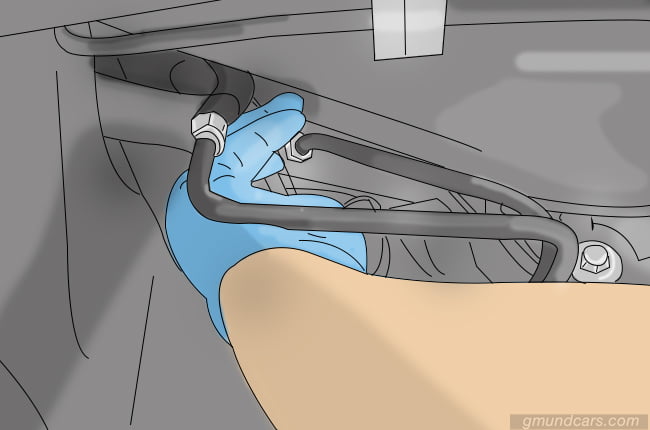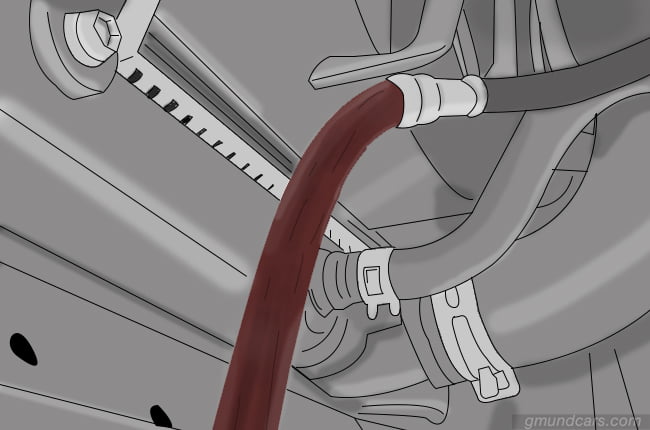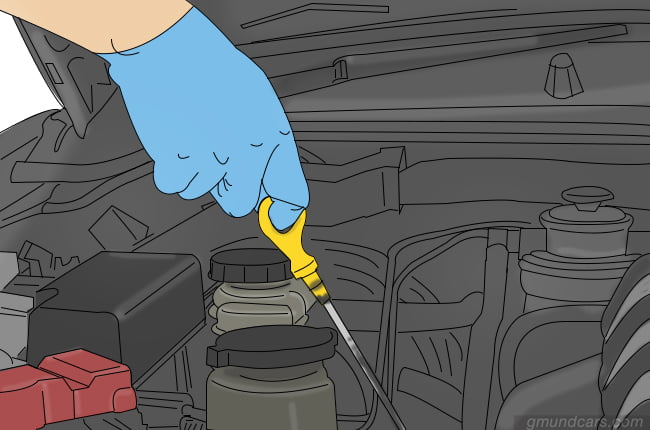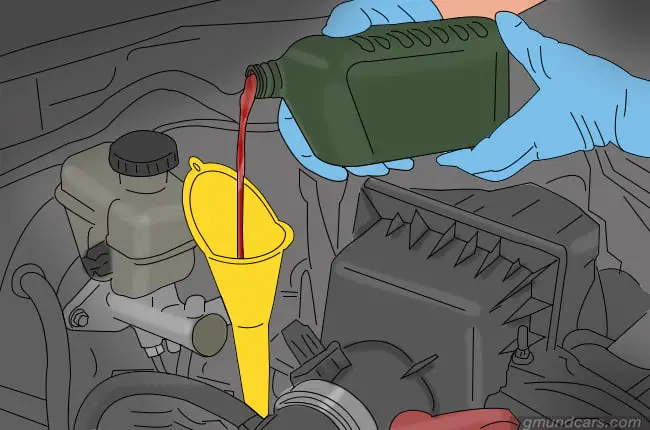Regarding transmission flush upkeep, I often find my clients expressing their doubts: “Timmy, is this procedure really necessary? Could it damage my vehicle? Is this something I can handle on my own?”
Well, you will ruin your transmission if you do it yourself. Give your mechanic money to do it.
I am just kidding, DIY only hurts the mechanic’s wallet, not your car’s engine. However, there are many things that you need to consider when taking this process. I wrote this article to provide you with:
- Deep knowledge of transmission flush
- When to do and when NOT to do.
- How to do it and other helpful information.
Explore further!
What is a transmission flush?
A transmission flush is a process of removing the old transmission fluid, grime, and sludge from your car’s transmission system and adding new liquid. This step is done using a professional-grade machine (if you are at the shop service) to connect to the transmission through the cooling lines to pump out the entire old fluid.
There are many debates on this process. Some people deemed that this job do more harm than good, while others indicate that this process will cause no damage to vehicle. Let’s see some benefits and risks that this maintenance procedure brings:
| Pros | Cons |
|---|---|
| - Have clean transmission components | - Wrong oil can be pumped into the system |
| - Prevent transmission issues | - Can not remove all the old fluid |
| - Keep the engine powered and lubricated | - Make a sudden clog in the system |
| - Save money on repair | - Unnecessary flush chemical can be used |
Benefits of transmission flush
Flushing your transmission system has some benefits, so if you are worried that the service will damage your car, throw your worries to the wind. Performing this maintenance can:
Ensure you have clean transmission components
Getting rid of gunk, residue, and rusts built up overtime is one of the many things transmission flush does. It also removes grime, varnish, dirty oxidized fluid, harmful deposits, gum, and sludge to improve shifting.
Prevent transmission issues
Do you want your engine to operate in lower quality? I guess you don’t. But do you know excessive wear in the system can keep your engine from performing at its best? Relax! A simple transmission flush can help eliminate the wear to reduce heat and prevent serious trouble with the transmission.
Keep the engine powered and lubricated
If the service is done, your engine will operate at maximum efficiency. With this, you will spend less on your car’s fueling.
Save money on repair
Repairing or replacing a transmission is no child’s play because it can be expensive. However, flushing the transmission can help you save money on your vehicle’s overall repair cost.
Will a transmission flush hurt vehicles?
Yes and No! Of course, if you do it the wrong way, you can hurt your car’s transmission system. However, if you follow the proper procedure, the service won’t cause any damage. While having this in mind, know that some risks may happen.
Wrong oil can be pumped into the system
Most of the service shops use the same flush machine to perform the service on many vehicles. If this machine is not meticulously cleaned, it can have a mixture of fluids which may not be perfect for the transmission system. Then, they use this machine to flush your vehicle, it can pump a small amount of wrong oil into the system, thereby hurting the transmission.
Can not remove all the old fluid
The machine can not remove all the old fluid and replace it with 100% new oil while the engine is running. It relies on the transmission pump to circulate. The flush machine will remove a little bit of old liquid and add a bit of new oil. This process continues until the new fluid in the container is completely empty. With the procedure, the old oil will mix with your new one, and you may get 80 to 90% new fluid in the car’s transmission system. A conventional transmission service can not replace all of your transmission liquid.
Make a sudden clog in the system
Chunks of debris can be dislodged when fluid is flushed out or forcefully pushed back into the transmission. As the particles move from one corner to another, they may block one-way valves or narrow channels. When adding new oil, the normal flow of fluid in the system can be inhibited by the blockage, causing lubrication issues like the inability to shift between gears.
Unnecessary flush chemical
Some shops add detergents, solvents, or other transmission flushing chemicals to the system before flushing the fluid. The chemical is allowed to circulate through your transmission by running the vehicle for about 15 minutes. The chemicals are completely unnecessary because they can damage sensors and internal seals, resulting in malfunctions down the road.
How often to flush the transmission
How often to flush the transmission varies depending on where, how, and the car you drive. I suggest that you check your owner’s manual to determine if your automaker recommends it. If not, continue reading Timmy’s article to know:
Manual vehicles’ transmission: Most mechanics recommend that you should perform this maintenance for manual transmission at least every 40,000 miles or two years.
Automatic vehicles’ transmission: It is recommended that automatic transmission flush should be done at every 60,000 miles or three years.
Timmy’s advice: If you want to save repair cost. I suggest that you should not flush your transmission system frequently. If you change the fluid regularly, doing the flush around 80,000 to 100,000 miles is okay.
When to get a transmission flush
| Should | Should not |
|---|---|
| Your car’s transmission got severe damage from contaminants and debris | Your vehicle has gone 100,000 miles or more and you’ve never done a transmission flush before |
| The transmission fluid is contaminated with other fluids | The fluid gives a burning smell and the color is dark black |
| The system’s components have become clogged due to debris or vanish build up | Your car manufacturers recommend AGAINST using transmission flushing chemicals |
| Use wrong type of transmission fluid | |
| Do as regular maintenance required from car manufacturer |
Let’s consider some cases that you MUST do a transmission flush for your transmission system:
Your car’s transmission got severe damage from contaminants and debris
When there are excess contaminants and debris in the system, it can interfere with the oil flow. This can cause severe damage like vehicle surge, make gears very hard to shift, and more. A situation like this may require a transmission flush.
The transmission fluid is contaminated with other fluids
The coolant can mix with the transmission oil and get contaminated if there is any rupture on the internal radiator tank, or due to the leakage. Also, moisture through dipstick, high water, or flood can enter the transmission vent to contaminate the system’s fluid. Besides, you may accidentally put engine oil in the transmission. If any of this happens, flushing the oil is needed.
The system’s components have become clogged due to debris or vanish build up
Transmission is made of many components that make your vehicle move. Vanish or debris build-up can clog the transmission fluid filter and other parts. This often results in the oil’s quality reduction, fluid flow obstruction and prevents the liquid from cooling and lubricating the components. In this case, you may require a transmission system flush.
An improper type of fluid in the system
Have you ever flushed your transmission but not sure what type of fluid should be used. Well, I guess that you did that without asking for your mechanic’s advice or reading Timmy’s article. Then you used the wrong type of transmission fluid. Oh, what a disaster! When you use improper fluid, it can cause transmission failure, overheating, and inadequate lubrication. Besides, you can experience rough shifting, clutch lockup, strange engine sounds, and more. So, if you have the wrong type of oil in the system, you must flush the transmission and replace it with the right one.
Do as regular maintenance required from car manufacturer
Even though it is scarce for modern automakers to recommend a system flush, some manufacturers do require this step as regular maintenance. Just consult your car’s manual and follow it.
When you car transmission DOES NOT need a flush
From my experience, there are some cases that transmission flush should not be done:
If your vehicle has gone 100,000 miles or more and you’ve never done a transmission flush before
My friend had a 2006 Cadillac DTS with 124,000 miles that hasn’t had regular transmission maintenance. The transmission almost died after flushing the fluid. The same thing happened to a customer who performed the service for his 2000 Chevrolet Venture at 190,000 miles and another car user of mine who did his own when the 2004 Chevy Malibu was 160,000 miles. So, I will advise that if your vehicle is at 100,000 miles or more and has not undergone a transmission flush before, doing it can result in transmission failure.
Do not flush your transmission if the fluid gives a burning smell and the color is dark black
Do you see little flakes or specks in the oil? Does the fluid give a burning smell, and the color is dark black? Ops! It means the liquid is oxidized. Some internal damages may have also occurred. Flushing the system at this point can cause a problem in the valve body. When this happens, you may have to replace the oil or repair the transmission.
Some car manufacturers recommend AGAINST using transmission flushing chemicals
I suggest that you check your car owner’s manual to determine if you can use solvents or detergents to flush the transmission. Many manufacturers recommend not to use transmission flushing chemicals. If manufacturers can prove that you use some of these chemicals for the engine, then, guess! transmission warranty will be denied.
Do you follow the manufacturer’s recommendation of changing oil as recommended? Then your vehicle does not need a transmission flush at all. Recalled what I said, this will help you save a buck.
Transmission change vs. flush: Which is better?
| Transmission fluid change | Transmission fluid flush |
|---|---|
| Remove about 50% of the old fluid | Remove all old fluid (actually 80 - 90%) |
| Use gravitational forces | Use flush machine/ cooler lines |
| More affordable | More expensive |
| Help restore your transmission to good working order | Give the assurance that your transmission fluid is brand-new and clean |
| Cause no harm to vehicles | Can damage vehicles in some cases |
Transmission fluid change is the procedure of draining the old oil in the system and changing the new filter. A larger percentage of build-up is removed during this process, and new fluid is added to the transmission. However, the old fluid is not entirely removed and replaced by the new oil. Even though performing this service will make your transmission work better, some build-up will still be in the car’s system. It means you will need to condition your fluid and keep monitoring its color.
On the other hand, the transmission flush eliminates the old fluid entirely and replaces it with new fluid. (No, it’s just a theory! Trust me, the truth is about 80-90% of new fluid. But, anyway, it’s enough!). Even though this process may be complicated and more time-consuming, it gives the assurance that your transmission’s fluid is brand-new and clean. It will also result in your transmission running much more efficiently and smoothly.
Overall, an oil change is a cheaper option and relatively simple task that will help restore your transmission to good working order if you have kept up with your system maintenance. However, a fluid flush is better if it has been a while since your last transmission service because it removes all the corroded oils and debris and cleans transmission components.
Read more: How often to change transmission fluid
How to flush the transmission?
Preparation
You don’t need special equipment or tools to do this job. The tools and supplies required are:
- Paper towels or rag
- Funnel
- Wooden block or wheel chock
- Socket set, ratchet, and wrench
- Ramps or jack stands and a floor jack
- New transmission fluid
- Drain pan
Note: Before you commence the process, check the fluid by removing the dipstick. If the oil has a burnt smell or appears dark, don’t flush the transmission. Filter and oil change will be the best thing to do.
Step by step guide
Step 1: Start the car to running temperature and then turn it off.
After warming your vehicle to normal operating temperature, put a wooden block or wheel chock behind one of the tires at the back, and use a floor jack to raise the car’s front. After doing this, place the jack stand under your vehicle and lower the floor jack, ensuring your ride rests entirely on the stand and maintains good stability.
Step 2: Locate the transmission cooler lines
The cooler lines run to the radiator from the transaxle or transmission. There are two lines in the system. One transports hot fluid to the transmission oil cooler or radiator. The second line returns the cooled liquid to the transmission system. Identify the lower line, which connects to the radiator – this is the one we will remove.

Step 3: Place the drain pan underneath to catch the old fluid and remove the cooler line
Once you locate the cooler line that needs to remove, put a drain pan under the disconnected transmission oil cooler line to collect the fluid that is dispensing. Ensure the pan is large enough to catch all the liquid coming out.

Step 4: Pull the dipstick
Open the hood, pull out the dipstick from the fill or dipstick tube, and insert a funnel. I recommend using a skinny funnel or small funnel with tube extension or small diameter holes. This helps you keep the funnel filled with oil easily when doing the maintenance.

Step 5: Pour the new transmission fluid
Start your car, open the new transmission fluid’s container, and pour the new oil continuously into the funnel. You will see the old oil coming out of the system via the cooler line into the drain bucket. After pouring all the fluid and turn off your engine.

Step 6: Reinstall the transmission oil cooler line
When you are done with step 5, reconnect the cooler line to the radiator, remove the funnel, and return the dipstick to its position. Ensure the dipstick is thoroughly cleaned or wiped with a dry rag that will not leave any moisture or dirt on it.
Step 7: Turn on the car engine again
Before you lower the vehicle, you need to start it and check for leaks. Shut the car off if there are no leaks and lower it. After this is done, you still need to turn on the engine again, ensuring it gets to a normal operating temperature. Move the shifter from one gear to another, pausing a few seconds between each shift before returning it to Pack position.
Step 8: Check the fluid level
While the engine is still running, remove the dipstick to determine the oil level. When you pull out the stick, wipe the fluid on it, reinsert it into the tube, and remove it again to confirm the fluid level. Do these 2 to 3 times, and if it is in the full range, things are perfect. Otherwise, if you are experiencing a low level of fluid, add more oil to top it up.
Do not allow the fluid to overfill your transmission. If this happens, you can remove the drain plug to let out some of the liquid. Your vehicle does not have a plug? Removing the cooler line that connects to the radiator will help you get the job done.
Estimated time to complete: Flushing out the old oil from your vehicle’s transmission system and adding a new one take longer than fluid change. It can take between 2 hours.
Transmission flush cost
The cost of transmission flush depends on many factors:
- Whether the job is performed: DIY, service shop or dealership.
- Where you live, labor cost
- Your car’s make and model
- Type of automatic transmission fluid vehicle uses
- Amount of fluid your vehicle requires
Let’s see the difference in price when you get the job done by yourself and by shop service help:
DIY
This is the best option for those who want to save money. Doing the service yourself can cost around $40 to $100. You can get the tools you need for about $12 and get the new transmission fluid between $8 to $20 per quart. So, the amount of oil your car takes will determine the number of quarts you need to buy. All you need to do then is follow the proper instruction given earlier and get everything done.
At service shops
You can pay around $100 to $300 or more to get your car flushed at service shops. However, the price can be different due to your location, your vehicle’s model. Below are some examples of different transmission flush cost in some shops service:
| Shop service | Price | Location |
|---|---|---|
| Addison Auto Repair & Body Shop | $240 | Denver |
| Japanese Automotive Service | $190 | Hilliard, Ohio |
| J & R Auto Repair | $240 | Glen Ellyn, Illinois |
| Pep Boys stores | From $180 | |
| Jiffy Lube | $100 to $200 |
Final words
We have come to the end of the article. You will be future mechanics, and I will get nothing; no money to feed my family. Just for fun! I am now sure that you are a master of transmission fluid. However, there are things you need to keep in mind.
If you follow owner’s schedule to change transmission fluid regularly, there is no need to flush it. Just do it when you really need to do. Moreover, a fluid flush is a preventive maintenance procedure, so don’t see it as a cure because it will not repair an internal transmission problem. However, if the service is done by following the procedure mentioned in this writeup, you can be sure of having a transmission system void of varnish, gum, sludge, dirty oxidized fluid, and harmful deposits. This will, in turn, extend the life of your transmission.
Wait for Timmy’s next article to be a future mechanic!
